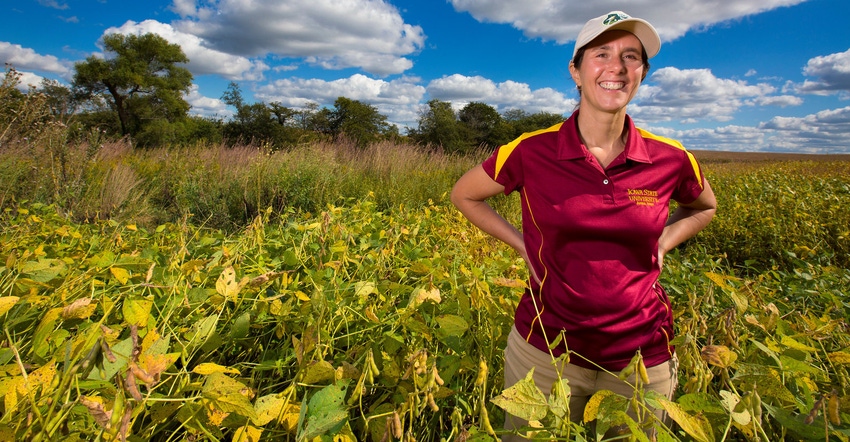
A series of publications is available covering everything farmers and landowners need to know about a conservation practice developed by Iowa State University scientists that has proven environmental benefits. The Science-based Trials of Row-crops Integrated with Prairie Strips (STRIPS) project involves converting 10% of a row-cropped field to strategically placed prairie strips. The practice has been shown to keep soil in place, improve soil quality, and reduce nitrogen and phosphorus from entering streams, rivers and lakes. And it enhances wildlife habitat.
“We’re excited about these new publications,” says Lisa Schulte Moore, STRIPS project co-lead and ISU professor of natural resource ecology and management. “They report on the substantial amount of practical experience our team has gained in the last few years working with farmers and farmland owners to implement prairie strips on their farms, in addition to our science findings.”
Helpful information
Five publications were recently published by ISU Extension. They are available free on the Extension Store.
The STRIPS publications include:
• “A Landowner's Guide to Prairie Strips,” AE 3609, provides an introduction to prairie strips for landowners.
• “Prairie Strips: Small Changes, Big Impacts,” AE 3610, summarizes the scientific research underpinning prairie strips.
• “The Cost of Prairie Strips”, AE 3611, breaks down the establishment and maintenance costs of prairie strips.
• “Farming with Prairie Strips,” AE 3612, provides an introduction for farmers.
• “Installing Prairie Strips: Frequently Asked Questions,” AE 3613, provides a detailed review of factors farmers and landowners should consider when implementing prairie strips.
Several fields around Iowa have been converted to include prairie strips. Demonstration sites are available for visits at Iowa State University Research and Demonstration Farms and the Neal Smith National Wildlife Refuge near Prairie City.
Strips help integrate crops with conservation
How are prairie strips different from standard contour buffers and filter strips? Schulte-Moore says prairie strips must be wide enough to handle the area of runoff from the contributing watershed. Edge-of-field prairie strips, similar to filter strips, are required to be used in tandem with contour prairie strips to ensure all of the water running off an area is filtered before it enters a surface water source such as a stream, pond or lake.
Buffer and filter strips are typically planted with cool-season perennials, usually brome or tall fescue, while prairie strips are planted to a mix of various native species.
The STRIPS project researchers first started working with growers in 2012 and are now working with 30 different farmers and landowners in Iowa and Missouri. “For all the farmers we’re working with, reducing erosion is their biggest goal. They want to keep soil on their fields,” says Schulte-Moore. “Also, because we slow that water down, we allow it to infiltrate, so it can be available to the crop later in the year. Much of the water is transpired as well, so you have much less water moving across the hill slope.”
Use CRP, EQIP to help establish prairie strips
Most farmers in the STRIPS program are using CRP to implement prairie strips, while some have used other cost-share programs available, and others are simply doing it on their own. Through CRP or the Environmental Quality Incentives Program, landowners can get creative and establish contour buffer strips, which are, for all intents and purposes, a prairie strip. Or landowners can establish contour buffers and receive compensation for foregone income through EQIP, which generally provides more flexibility in the width of contour buffer strips. Unlike the STRIPS program, these are typically limited to 15 to 30 feet in width and aren’t always accompanied by a filter strip.
Most farmers, if they establish a conservation structure, do it for multiple reasons: to meet conservation objectives but also as an additional income. There may be some additional roles buffer and filter strips can fill. For example, some include native pollinator mixes, Roundup Ready alfalfa strips and switchgrass strips.
Controlling weeds in prairie strips
Native prairie strips, in particular, require an added level of management, especially when it comes to controlling weeds like marestail. Schulte-Moore says weed issues can be overcome through frequent mowing in the first year and potentially the second year. After that, spot treatments will be needed.
While they aren’t prairie strips in the conventional sense, switchgrass strips or Roundup Ready alfalfa strips provide a chemical alternative to control weeds that encroach on the strip, while still serving the benefit of controlling erosion.
While alfalfa provides an additional hay source for farmers who can find a way to properly cure it in the middle of a cornfield, switchgrass or prairie strips could also serve as an additional source of cattle feed. Farmers could harvest and grind forage from switchgrass or prairie strips later in the season and mix them with distillers grains.
Prairie strips reduce nutrient runoff
In addition to their erosion control benefits, prairie strips also reduce nutrient runoff. From 2007 to 2012, STRIPS researchers found fields with only 10% prairie reduced sediment loss by 95%, total phosphorus loss by 90% and total nitrogen loss by 85%, compared to losses from fields consisting completely of no-till annual crops.
There are also long-term benefits for soil health: building organic matter and infiltration over time. All of the benefits take an added level of management to achieve. This is not short term; it’s long term, says Schulte-Moore. That’s a hard thing for agriculture to get its arms around sometimes: the value of soil conservation. The vehicles you buy now, you don’t have to check the tire pressure. You push a button and it tells you. The land isn’t like that. It doesn’t have those kinds of buttons.
About the Author(s)
You May Also Like




